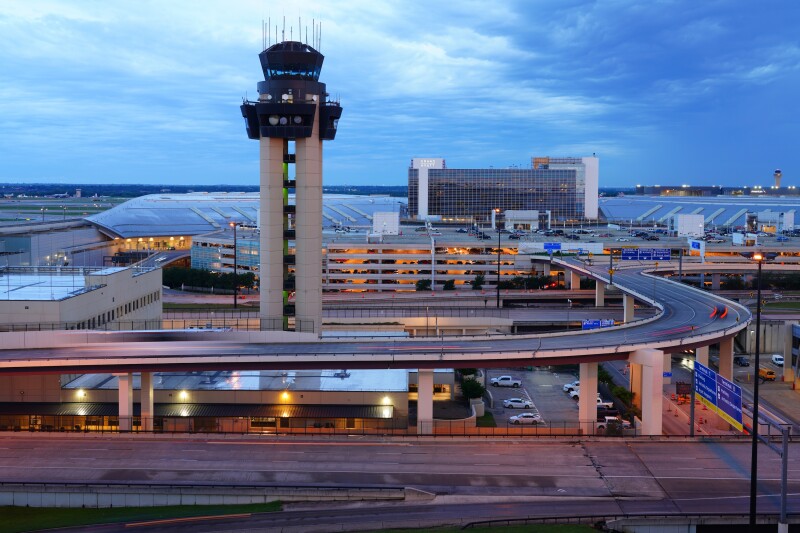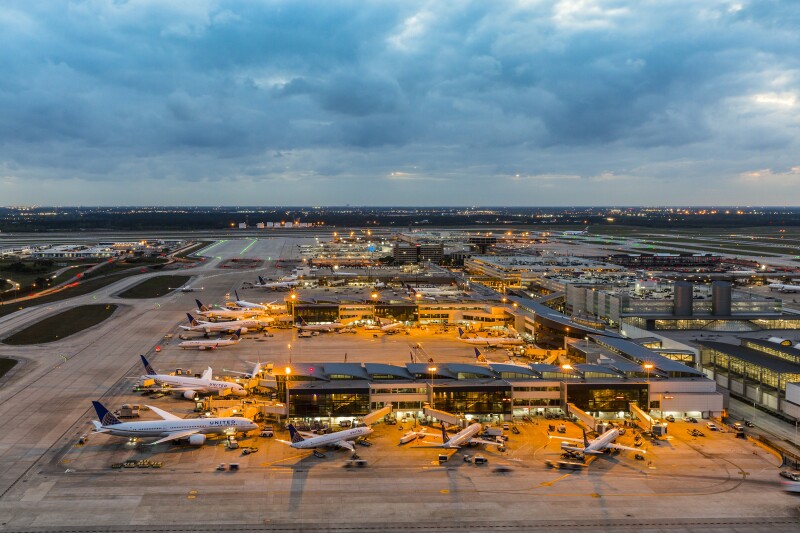A big airport can sometimes feel like a teeming metropolis—or an “aerotropolis” as it were, a term coined to describe these rising mega-airport-cum-commerce centers. In fact, the largest U.S. airfields, in terms of area covered, are literally as big as a decent-sized city. And, just like any major city, they also seem to be in a constant state of demolition and reconstruction, with sprawling new terminals being erected to accommodate an ever-growing population of travelers. Last year, U.S. airports handled more than 1 billion passengers flying on U.S. and international carriers, according to the U.S. Bureau of Transportation Statistics, and the number is expected to only continue to rise in the coming years.
So, what are the biggest U.S. airports in terms of land mass? Interestingly, they’re not necessarily the busiest; in fact Atlanta’s Hartsfield-Jackson International Airport, which handles more passengers annually than any other airport in the world, isn’t even in the top 10 when it comes to sheer size. Here, is the ranking based on the airports’ own published dimensions and local government data.
1. Denver International Airport (DEN): 53 square miles
Denver International Airport is the second largest airport in the world after the humongous King Fahd Airport in Saudi Arabia—it’s so huge that it’s more than double the size of the next largest U.S. airport, Dallas Fort Worth. At 53 square miles, it’s larger than the cities of San Francisco, Boston, and Miami. And that’s no accident. In the 1990s, when the city of Denver chose to scrap its close-in but outmoded airport Stapleton, it opted to build the replacement airfield on a site that was 25 miles from downtown. The extra breathing room allowed it to build six runways, and the Denver hub recently completed a terminal expansion that added 39 new gates, bringing the total number of gates across the airport’s three terminals to 90 (a 30 percent increase over its previous capacity). The airport only takes up a fraction of the massive space it owns, and given all that extra square footage, it offers many ways to experience the outdoors, including an 82,000-square-foot outdoor plaza that’s open to travelers as well as to the general public. Its terminals also boast three outdoor decks, post-security, with views of the Colorado plains in the distance.

Dallas Fort Worth International Airport is one of the biggest and busiest airports in the country—and it’s also bigger than Manhattan in New York.
Shutterstock
2. Dallas Fort Worth International Airport (DFW): 26 square miles
The phrase “everything is bigger in Texas” doesn’t just refer to big hats and big hair—it could also describe its super-sized airports: The Lone Star state is home to two of the biggest U.S. airports. And as the home base of the world’s largest carrier, American Airlines, Dallas Fort Worth International Airport occupies a footprint that is bigger than the island of Manhattan; it even has its own zip code, plus five terminals with a total of 168 gates. Size doesn’t prevent it from being a model for sustainability, with plans for a zero-carbon electrical plant that will help it achieve net-zero emissions by 2030. With seven operational runways, the airport is able to handle more than 73 million fliers a year, who no doubt appreciate DFW’s wide array of food choices and the opportunities to work it off with an internal walking path and yoga studio.

For a relatively small hub, Southwest Florida International Airport in Fort Myers, Florida, occupies a huge chunk of land—and there’s an interesting reason why.
Christoffer Hansen Vika/Shutterstock
3. Southwest Florida International Airport (RSW): 21.2 square miles
While not large in passenger numbers—it handled just over 10 million fliers last year—Southwest Florida International Airport in Fort Myers is nonetheless the third biggest airport in the U.S. in area. Well positioned as the gateway to Florida’s southwest region, it serves such destinations as the Cape Coral–Fort Myers area, as well as Naples, Marco Island, and Punta Gorda. What’s the reason behind the big footprint? It’s not for future development, but for land conservation. Some 6,000 acres of its total area have been designated as protected swamp lands. But the airport itself isn’t sitting still; an ongoing terminal expansion is due to be completed in early 2025.

One of the most exciting developments at the sprawling Orlando airport was the recent opening of a Brightline train station.
Courtesy of Brightline
4. Orlando International Airport (MCO): 20.7 square miles
Located six miles from downtown Orlando, this airport is the main international gateway for central Florida and its world-famous theme parks. And as the seventh busiest airport in the country, Orlando International Airport now has 850 daily flights on 44 airlines, bringing hordes of tourists from the U.S. and abroad to experience this popular family-friendly resort town. Last year, MCO handled nearly 58 million passengers, a record for the airport and a 15 percent increase over the previous year. The airport recently opened the new $2.8 billion Terminal C and Florida’s new private high-speed rail line Brightline has unveiled a station at the airport.

It’s hard to miss the iconic Eero Saarinen-designed silhouette of Dulles.
Photo by Cyrus Crossan/Unsplash
5. Washington Dulles International Airport (IAD): 18.7 square miles
When Dulles airport opened in a rural area of Northern Virginia in the early 1960s, its expansive property was seen as a drawback; located 30 miles from the capital, Beltway insiders regarded it as something of a white elephant, despite its striking Eero Saarinen–designed terminal. Now, it’s a budding aerotropolis with a large number of technology companies and defense contractors nearby. A major hub for United Airlines, the airport has flights to 57 international and 86 domestic destinations. While it can still take nearly an hour to drive there from the district, a Metro line expansion now offers a public transit alternative.

Houston’s main air hub is a testament to planning for future growth.
Julie Soefer/George Bush Intercontinental Airport
6. George Bush Intercontinental Airport (IAH): 17.1 square miles
In the late 1950s, when Houston civic leaders purchased land for a new airport, they were already thinking big—and in the ensuing decades its real estate was expanded to its present size. George Bush Intercontinental Airport Houston now features five runways that can handle a high number of long-distance flights to Latin America and beyond, with Houston serving as a main hub for United Airlines. In early 2025, the airport is slated to open a new international terminal between terminals D and E, which will be needed as the airport handled a record 46 million fliers last year.

Straight off the plane and straight for the slopes—Salt Lake City International Airport is less than an hour from world-class skiing in and around Park City, Utah.
James Udall/Salt Lake City International Airport
7. Salt Lake City International Airport (SLC): 12 square miles
Salt Lake City International Airport, a major hub for Delta Air Lines, can rightfully boast that it’s the “first U.S. hub airport built in the 21st century,” with a new complex that opened in 2020 to replace a woefully out-of-date 60-year-old facility. The first phase of the $4 billion project got high marks from fliers for its modern design, a spacious layout, and art installations inspired by the state’s unique topography. The airport has recently seen an uptick in international traffic with nonstop service to foreign destinations like Amsterdam, London; and Paris; it’s now serving more than 26 million passengers a year and will be able to handle up to 34 million when the final phase of its new terminal opens in 2026.

Time to spare at O’Hare? Check out all the cool public art in and around this massive air travel center.
Patrick L. Pyszka/City of Chicago
8. Chicago O’Hare International Airport (ORD): 11.25 square miles
Chicago’s main airport is so busy that it has at times come close to toppling Atlanta’s record for numbers of passengers carried, with nearly 74 million passengers transiting the gateway in 2023, most of them flying on ORD’s two dominant airlines, American and United (the latter is based in the Windy City). In sheer size the airport is no slouch either; there are 202 gates at O’Hare and eight runways, believed to be the most runways of any commercial airport in the world. The airport recently embarked on a massive, $8.5 billion terminal modernization program, due to be completed in 2028.

San Francisco International Airport is big but at least it’s easy to connect to San Francisco via the BART public transit system.
Ivan Mendoza/Unsplash
9. San Francisco International Airport (SFO): 8.14 square miles
With 50 million total passengers in 2023, San Francisco International Airport is a major gateway for travel to the Asia Pacific region, so it’s no surprise that it boasts the country’s largest international terminal at 1.8 million square feet, including a sizable customs facility that can process 5,000 arrivals an hour. At SFO, fliers can also enjoy several outdoor spaces, including a new Sky Terrace before security at Terminal 2 with 180-degree views of the airfield from an observation area, and a gallery with exhibits on the airport’s history. Befitting its location, the airport is earthquake resistant, capable of withstanding a magnitude 8 quake (the last major one to hit the area was 6.9 on the Richter scale.)

A rendering of the new, fully connected and greener JFK that is on the way.
Courtesy of the Port Authority of New York and New Jersey
10. John F. Kennedy International Airport (JFK): 8.1 square miles
New York City’s JFK airport has come a long way since it opened in 1948 as Idlewild Airport on the site of a former golf course; after it was renamed in honor of the late President Kennedy in 1963, it was the international gateway to the U.S. Back then it took advantage of its ample land area to create outdoor plazas with fountains and landscaped parks, which were eventually paved over in favor of more roadways and terminals. It’s now undergoing yet another massive overhaul that—with the benefit of hindsight—will create a better, greener airport. And it will also greatly increase the airport’s indoor space; with 62 million passengers a year, arriving on 90 airlines, JFK still reigns as the busiest in the U.S. for international traffic.








